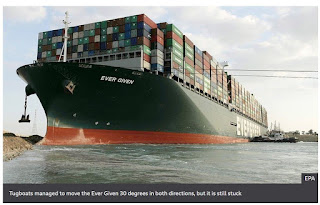One of the
great advantages of the
container revolution has been the
reliability
it has afforded to the global
production-transport-distribution system.
It was as a matter of fact the container that ushered in the JiT systems and the
consequent minimization of inventories.
JiT has
impacted not only transport, but each and every aspect of our lives. When I travel,
I know exactly what time I must leave home to get to Schiphol airport by, say,
17h45. But if the Metro does not run; the taxis are regularly on strike; or the
motorways congested during peak hours, then I need to leave home one hour
earlier. And this hour is my own ‘inventory cost’.
In ports in
particular, containerization totally revolutionized the landscape: i.e., port
operations, planning, development, competition, and the regularization of port
labor. Pressure on port space is now relieved, and ship-time in port minimized.
These developments have increased ship and port productivity immensely and have
allowed ships to become ever bigger. By-passing the waterfront in the
stuffing and stripping of containers, and thus having them ready in port to be
handled by automated equipment, increased immensely the predictability and
reliability of cargo movements, and enabled manufacturers and traders to reduce
high inventory costs through the adoption of flexible Just-in-Time and Make-to-Order
(MtO) production technologies. Inter alia, such technologies have helped
manufacturers to cope with the vagaries and unpredictability of the business
cycle and plan business development in a more cost-effective way.
Maersk’s boss,
Soren Skou, seems to believe that all this may be changing. In an interview in
the Financial Times (April 1, 2021) he seems
to claim that we may be willing to shift away from JiT and MtO, in other words,
we may be prepared to assume higher inventory costs, in order to protect
ourselves from disruptions such as those of COVID-19 or the blockage of Suez by
Evergreen’s Ever Given.
This is indeed a shot from the hip and I would strongly
question it: The costs of securing our supply chains, reconfiguring them and
making them more resilient to disruption, are far far less than the costs we
would be imposing on our fine-tuned global trading system by an increase in
inventory costs (and the implied unreliability); we have made this calculation countless times.
Of course,
for a carrier, some unreliability might come in handy but, this time,
the consumer will just not buy it.
HX









